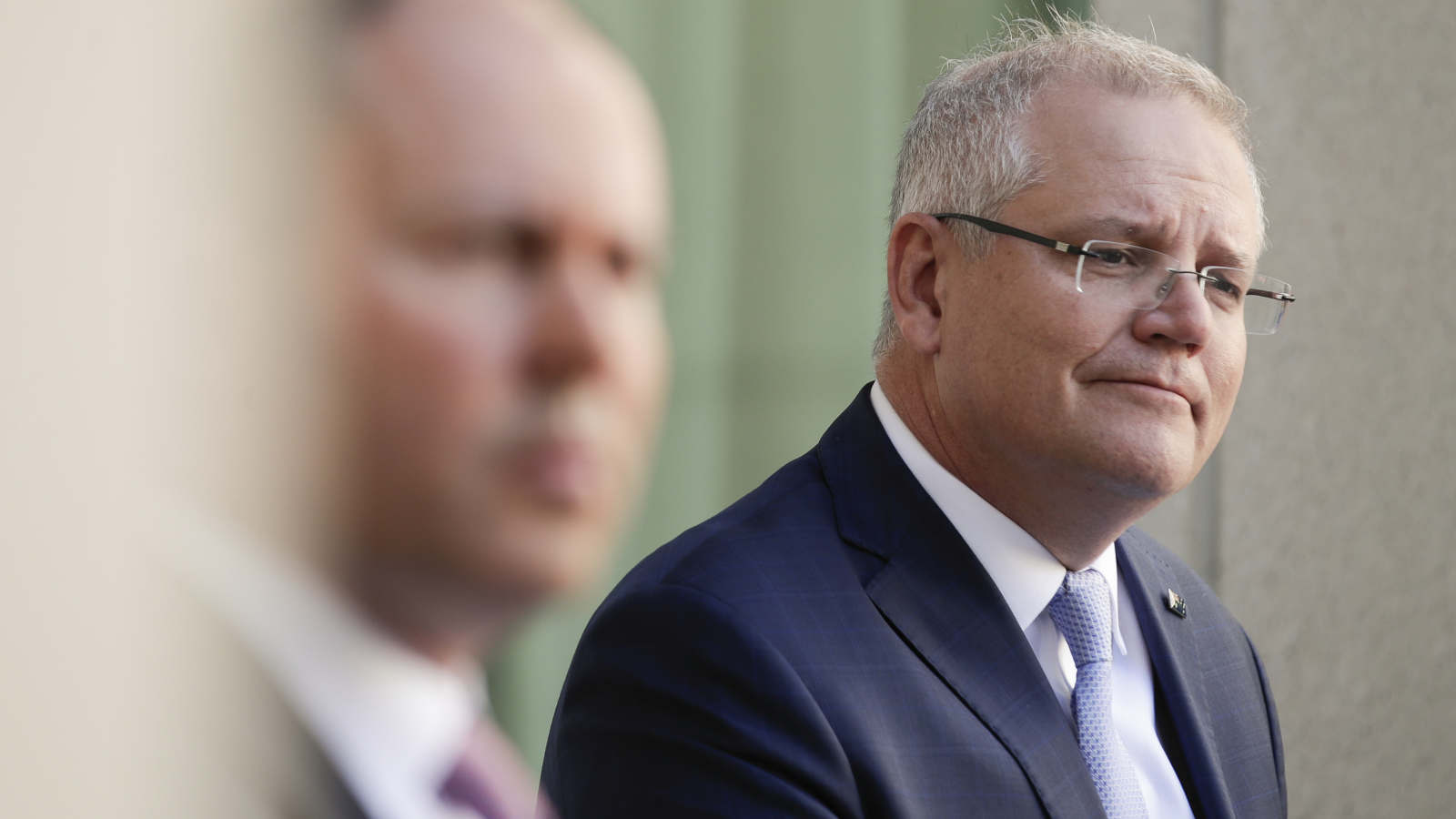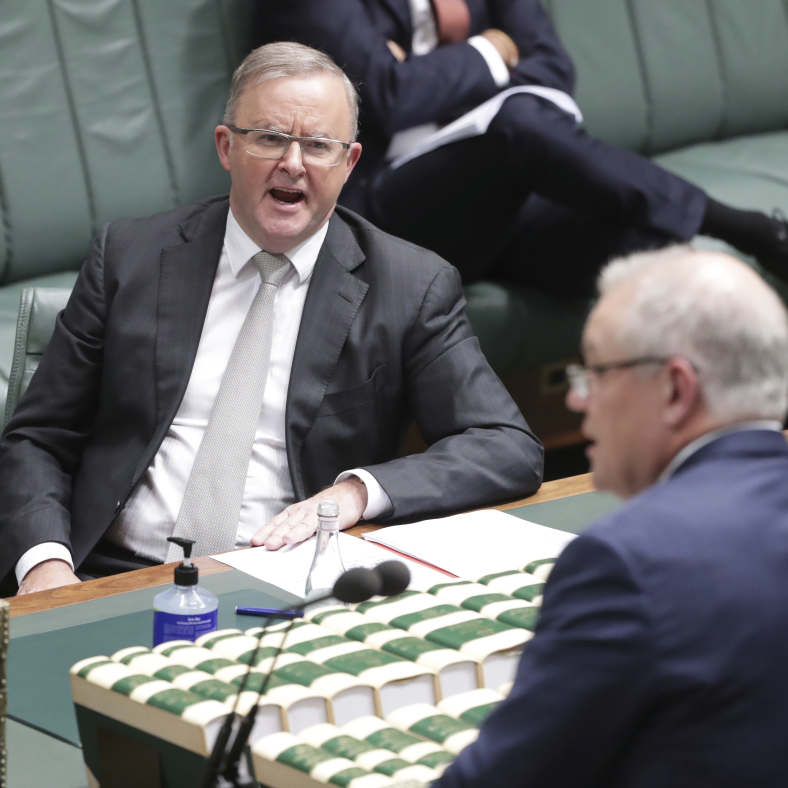Lead and we follow: country of over-achievers in times of crisis
by George MegalogenisThere is a rhythm to the global shocks of the 21st century that should be familiar by now. Australia rises to the challenge, while the United States offers a counter example of systems failure.
Last week we grieved the death of the 100th Australian victim of the coronavirus. This week, the US became the first country to pass 100,000 confirmed deaths. The global pandemic of 2020 traces the storyline of the Great Recession of 2008-09 when Australia's unemployment rate remained below 6 per cent while in the US it peaked at 10 per cent.

Leadership, and a respect for expert advice, only partly explains Australia's success. It is our obedient nature as a people in a crisis that turns a timely policy response into over-achievement. Kevin Rudd told us to go shopping as an act of patriotic duty in 2008, so we spent our stimulus cheques.
This year, Scott Morrison told us to stay at home, so we learned how to make sourdough. Australians want to be led.
Americans divide in a crisis across pre-existing faultlines of race and class, and they vent directly at authority. Conservatives bearing arms have occupied state legislatures, demanding an end to lockdown. This week, there was a spontaneous protest from the left triggered by the latest brutal police killing of an African American. The tragedy of civil disorder isn't just repeating in the US; it's accelerating. There had been a two-year gap between the launch of the Tea Party movement in 2009 and Occupy Wall Street in 2011. The two never crossed paths. Now the white pride and Black Lives Matter movements may be one provocation away from open street-fighting.
This comparison should reassure us, but the evidence of the last crisis is that national unity lasts only as long as the emergency. In the decade following the Great Recession, we had five prime ministers, and virtually no policy achievement.
There is another lesson from history, running back to the 1970s. No prime minister has survived a global shock, regardless of how well they managed the response. The 1974-75 recession destroyed the government of Gough Whitlam. Malcolm Fraser's fell with the 1982-83 recession. Bob Hawke lost his leadership in the aftermath of the 1990-91 recession, while Rudd was toppled by his own party within a year of dodging the Great Recession.
Paul Keating, the seeming exception to the rule, won a fifth term for Labor in 1993 despite an unemployment rate of 11 per cent. But he lost the next election in a landslide. Australians are prone to whingeing once the immediate danger passes. We question whether the government over-reacted. Could we have avoided the Great Recession without Labor's stimulus? Did we really need to shut down the economy under the coalition to suppress the coronavirus?
The warning signs of our contrary nature can be seen in the potshots that Morrison government members have been taking at Labor premiers, undermining the national cabinet's first principle of shared leadership.
The political nature of these attacks is betrayed by the absence of an equivalent comment against Liberal premiers implementing similar policies. Tasmania has been hastening just as slowly as Victoria in easing restrictions; Tasmania and South Australia have been just as reluctant to re-open their borders to NSW as Queensland or Western Australia.
Even the Prime Minister couldn't help dividing the states between Labor recalcitrants and Liberal heroes at his press club address on Tuesday. "It may well be that Sydneysiders can fly to Auckland before they can fly to Perth, or even the Gold Coast," he joked.

Federal Labor is matching the coalition's pettiness with its own opportunistic sniping.
The response to Treasury's costings blunder on the JobKeeper payment mimicked the attack lines that Tony Abbott used about debt and deficit when he was opposition leader a decade ago.
"This is a Government that couldn't run a bath let alone be good economic managers," Opposition leader Anthony Albanese roared last Saturday. "The fact is that if you can't get this right, how can the Government get economic recovery right?"

The incentives of Australian politics reward the party that complains about the cost of things, while media elevates the sceptic who nit-picks the forecasts which proved too pessimistic. We are a marvel of national unity in a crisis. Not even the 1990-91 recession, with its policy blunders and the self-indulgence of the Hawke-Keating leadership war, pushed us down the American road of civil strife. It is the recovery that divides us along familiar lines of entitlement and tribal loyalty.
Labor is still scarred by its failure to convert the policy triumph of 2008-09 into a long-term government with a lasting legacy of reform. In opposition, it is torn between constructive engagement with the coalition - a courtesy it was denied in office - and the temptation to press the buttons of community resentment for political gain. The byelection for the seat of Eden Monaro, in southern NSW, will test Albanese's judgment and temperament. Morrison failed the equivalent test in 2018, when he faced a byelection for Malcolm Turnbull's old seat of Wentworth, in Sydney's eastern suburbs.
For Labor, official forecasts are easy to mock at the moment. But Albanese would recall the paradox of 2008-09, when government intervention in the economy exceeded expectations.
Treasury was still predicting a recession in the 2009 budget, despite two rounds of stimulus. Unemployment was supposed to remain above 8 per cent throughout 2009-10 and 2010-11. It never got to 6 per cent under Labor.
Interestingly, it finally crossed 6 per cent following the release of the Abbott government's first budget in 2014. The backlash to that document poisoned the well for tax and spending reform for the remainder of the decade.
What Treasury couldn't put a figure on in 2009 was the boost to confidence from a crisis avoided. The stimulus showed the government was prepared to spend whatever it took to defend the economy, and employers responded by hanging onto their staff.
But then Treasury overshot in the recovery by assuming that revenues would snap back to normal with employment growth. It was never going to happen without serious fiscal repair because the tax base had been undermined by excessive handouts in the Howard years. Labor wasn't willing to take the risk of deep cuts to government spending while the recovery was fragile. It left office in 2013 without the early return to surplus it had been promising.
The coalition has its own fiscal demons. The budget was finally tracking for surplus when the pandemic stuck. Now it faces an unprecedented deficit, notwithstanding the dramatic revision to the JobKeeper payment, which will now be worth $70 billion rather than $130 billion.
There is an element of the 2009 experience in the costings drama. Once again, Treasury was too pessimistic in its initial assessment. But the Government will get no credit for spending $60 billion less on JobKeeper than it thought it would. Those who missed out will understandably want to be added to the scheme. And as both Treasury and the Reserve Bank have pointed out, the payment may need to be extended beyond September if the economy remains vulnerable to further shocks.
Another echo from 2009 is the argument over the modelling of the coronavirus. None of the health projections imagined the caseload and death toll would be as small as what we have at the moment. But that doesn't diminish the argument for lockdown. It just means the experts couldn't put a figure on our obedience.
As Professor James McCaw, from the University of Melbourne's School of Mathematics and Statistics and the Melbourne School of Population and Global Health, tweeted in mid-May, the modelling didn't over-estimate the risks of COVID-19.
"Rather it underestimated society's ability to respond and prevent transmission," he wrote. "Stay safe!"
Consider the bleak picture overseas. The American death rate per head of population is currently 77 times Australia's. In Sweden, which kept its economy open, the death toll is 100 times ours; in Britain which had kept its border open until recently, it is 140 times ours. Depending on which country you take as the benchmark, our policy response helped save between 7700 and 14,000 lives.
It is an argument the government can make with credibility. Whether is has any more salience than the Treasury numbers in 2009, which showed unemployment hitting 10 per cent without stimulus, remains to be seen.
On the other side of over-achievement is complacency. Every European and Asian country that has eased restrictions has seen their infection rate rise. How will the Australian psyche cope if there is a second wave of the coronavirus? Public opinion of Morrison and his government may well snap back to the position it was during the black summer of fires.
There is a lesson in the last deep recession about what lies ahead for the Morrison government. The Keating government won the 1993 election by recasting itself as the opposition against John Hewson's Fightback package. Morrison pulled off a similar escape last year by making the election a referendum on Labor's then leader Bill Shorten and his tax and spending program. What ultimately brought Keating down was the idea that he was offering something for nothing; in this case a tax cut without the GST.
The horror budget of 1993, which cancelled half the value of those tax cuts, and a series of interest rate rises in 1994 were, by his own admission, the things that finished off his government. These were the delayed political costs of recession, when fiscal and monetary buffers had to be rebuilt for the next shock.
This recession is only in its first quarter. It looks like no other in modern history because it started with a pandemic. But there is one disturbing parallel with a long-forgotten recession behind the old tariff wall. When the economy collapsed in the mid-1970s, there was no get-out-of-jail card for Australia. The US, Europe and Japan, then our largest trading partner, all went into recession together.
The danger in this pandemic is that Australia has no tangible economic reward for flattening the infection curve while the virus continues to threaten the US, Europe and China.